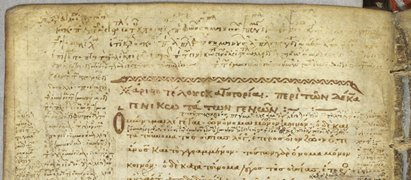Multilayered Manuscripts in the Transmission of Aristotle’s Organon
2019–2025
RFD07

The Organon, namely the collection of Aristotle’s six treatises on logic, scientific reasoning, and theory of argumentation, was passed down to us in circa 150 Greek manuscripts written between the 9th and the 16th century. Most Organon manuscripts are complex objects reflecting a long, open textual and material transmission. They are prime examples of multilayered artefacts, for, in addition to a core and paracontent written during the first production process, they contain a web of layers of disparate qualities and origins, resulting from different users’ engagement with the manuscripts over centuries. Such layers consist in, for instance, emendations to the core or paracontent (by conjecture or collation), exegetical notes explaining the rather difficult core text (mainly more or less reworked quotations from independent late-antique or Byzantine commentaries), added folios containing core or paracontent that had been lost after the first production process. Focusing on well-chosen case studies, this project explores the practices employed by the scribes, scholars, and laymen who introduced additional layers to historically, codicologically, and philologically relevant Organon manuscripts. This investigation reveals the origins, goals, and individual fates of the analysed layers as well as their relationship with the first production unit of the manuscripts that contain them. Furthermore, it allows us to evaluate the constituent principles of layers in Organon manuscripts and compare their implementation in this context to those found in different manuscript cultures investigated at the Cluster. In addition to conceptualising general and specific features of multilayeredness in Organon manuscripts, a further goal of this project is to shed light on some parts of the Greek manuscript tradition of the Organon, especially for the First and Second Analytics, whose story remains mostly untold. Thus, our project aims to establish a partial stemma codicum of the Analytics, based on textual, material, and cultural analyses of the manuscripts of interest and the families and groups to which their core and paracontent (as well as their different layers) are related.
The manuscript and text phenomena that are of interest to us are, among others, ‘contamination’, ‘physical evidence’, ‘composite manuscripts’, ‘disiecta membra’, ‘palimpsests’, and ‘paracontent’. Our approach is multidisciplinary and involves Philology, Textual Criticism, Manuscript Studies, Codicology, Palaeography, History, and the Natural Sciences (mainly ink analysis and MSI analysis).
